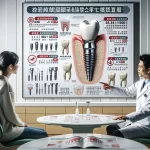Dental veneers have gained popularity as a transformative cosmetic dentistry solution, offering individuals the chance to enhance their smiles by covering the front surfaces of their teeth with custom-made shells. However, several myths and misconceptions can lead to confusion and hesitation about this procedure. In this comprehensive guide, we will debunk ten common myths surrounding dental veneers, providing clear explanations to help you make informed decisions about your dental care.
Myth #1: Veneers Look Fake and Unnatural
Reality: Modern dental veneers are meticulously crafted to look incredibly natural, blending seamlessly with your existing teeth. Think of them as a custom-tailored suit for your smile—designed to match the size, shape, and color of your natural teeth. Skilled cosmetic dentists use advanced materials that mimic the light-reflecting properties of enamel, ensuring a lifelike appearance that enhances your smile while maintaining authenticity.
Myth #2: Veneers Are Only for Cosmetic Purposes
Reality: While veneers are primarily known for their aesthetic benefits, they also serve functional purposes. They can protect and reinforce chipped or worn teeth, providing both aesthetic enhancement and structural integrity. Consider veneers as a protective shield for your teeth—offering a dual benefit that addresses both cosmetic concerns and functional issues.
Myth #3: Getting Veneers Is a Painful Process
Reality: The process of obtaining veneers is generally painless due to modern dental techniques and anesthesia. Before the procedure, your dentist will numb the area around the teeth receiving veneers, ensuring your comfort throughout treatment. Imagine it like getting a haircut—there may be minor discomfort, but overall, it is straightforward and manageable.
Myth #4: Veneers Require Extensive Tooth Preparation
Reality: Contrary to popular belief, veneers require minimal tooth preparation. Modern veneers can be as thin as contact lenses, necessitating only slight enamel removal. Think of them as a delicate layer that enhances your teeth without significant alteration—allowing for a natural fit.
Myth #5: Veneers Are High-Maintenance
Reality: Caring for veneers is similar to maintaining your natural teeth. With proper oral hygiene practices—brushing twice daily, flossing regularly, and visiting your dentist for routine cleanings—your veneers can last for many years. They are designed to be low-maintenance, allowing you to enjoy your beautiful smile without excessive effort.
Myth #6: Veneers Are Fragile and Easily Damaged
Reality: Made from durable materials like porcelain or composite resin, veneers are designed to withstand normal biting and chewing forces. With proper care—avoiding habits like nail-biting or chewing on hard objects—your veneers can last for many years without significant damage. Think of them as a sturdy protective layer for your teeth.
Myth #7: Veneers Stain Easily
Reality: Porcelain veneers are highly resistant to staining compared to natural tooth enamel. This means you can enjoy beverages like coffee or red wine without worrying about discoloration. Imagine having a stain-resistant fabric; similarly, porcelain veneers maintain their shine and color over time.
Myth #8: Veneers Are Only for Front Teeth
Reality: While most commonly applied to front teeth for cosmetic purposes, veneers can also be used on premolars or even molars to address various concerns. Think of veneers as a versatile solution that enhances your entire smile—not just the visible parts.
Myth #9: Veneers Are Permanent and Cannot Be Removed
Reality: Although considered semi-permanent, veneers can be removed if necessary. However, removing them may require additional dental work to restore the appearance and function of the underlying teeth. Picture them as a temporary façade; they can be replaced or removed if needed.
Myth #10: Veneers Are Prohibitively Expensive
Reality: While an investment in your smile, veneers are often more affordable than many assume. The cost varies based on factors such as the number of treated teeth and materials used. Consider them a long-term investment in your confidence—much like acquiring quality jewelry that enhances your overall appearance.
Understanding the Impact on Dental Health
Recognizing these myths versus realities is crucial for maintaining good oral health:
- Encouraging Good Oral Hygiene: Debunking myths about high maintenance encourages patients to adopt proper hygiene practices.
- Setting Realistic Expectations: Addressing misconceptions helps patients align their expectations with reality.
- Reducing Dental Anxiety: Clarifying that the process is generally painless alleviates fears associated with cosmetic treatments.
- Empowering Informed Decisions: Providing accurate information enables patients to make educated choices regarding their dental care.
By understanding these common myths about dental veneers, you can confidently explore whether they are right for you. A skilled cosmetic dentist will guide you through the process, ensuring that your new smile looks natural while enhancing both appearance and function.
Conclusion
In conclusion, debunking these myths about dental veneers empowers you with knowledge essential for making informed decisions regarding cosmetic dentistry options. Remember that an experienced cosmetic dentist can address any concerns you may have while helping you achieve the smile you’ve always wanted. For more detailed information on dental procedures and options available to you, visit reputable sources such as American Dental Association or American Academy of Cosmetic Dentistry.
Are dental veneers suitable for everyone?
Dental veneers are a versatile solution for many, but they’re not suitable for every individual. Ideal candidates should have healthy gums, a sufficient amount of enamel, and no severe habits of teeth grinding or clenching. It’s essential to consult with a dentist who can assess your specific needs and recommend the best course of action.
How long do dental veneers last?
The lifespan of dental veneers varies depending on the type of material used and how well they are cared for. Porcelain veneers generally last between 10 to 15 years, while composite resin veneers may last around 4 to 8 years. With meticulous oral hygiene and regular dental check-ups, some veneers can last even longer.
Can dental veneers become stained over time?
Porcelain veneers are highly resistant to staining thanks to their non-porous material. However, maintaining good oral hygiene and regular professional cleanings are important to prevent potential surface stains from building up over time, especially on composite resin veneers.
What is the maintenance routine for dental veneers?
Dental veneers require a maintenance routine similar to natural teeth. This includes brushing twice daily with a non-abrasive toothpaste, flossing once a day, and attending regular dental check-ups to ensure their longevity. It’s also advisable to avoid biting into hard objects to prevent chipping.
Are dental veneers a cost-effective solution?
While the initial cost of dental veneers may seem high, they should be viewed as a long-term investment in your dental health. Porcelain veneers can last up to two decades, often making them more cost-effective over time compared to other dental treatments that might need more frequent replacement or repairs.







